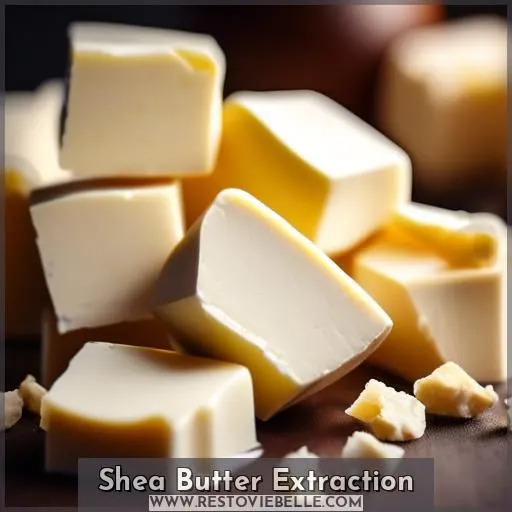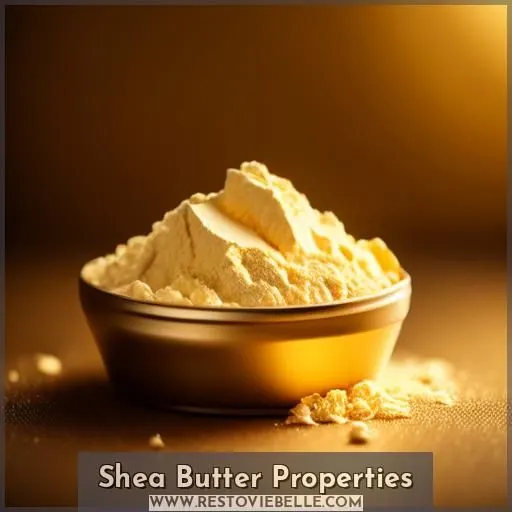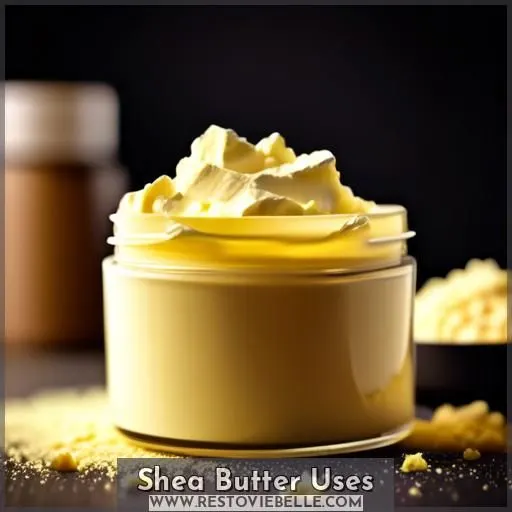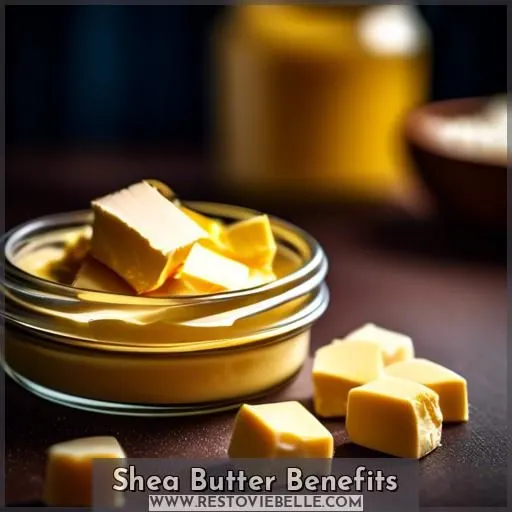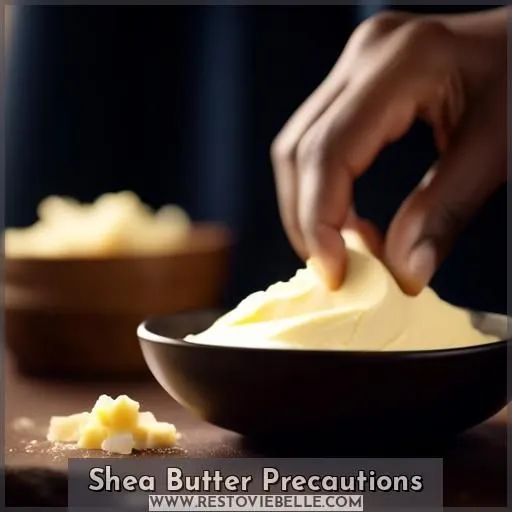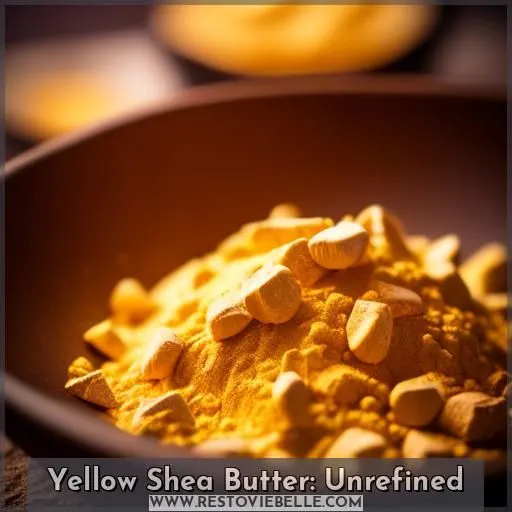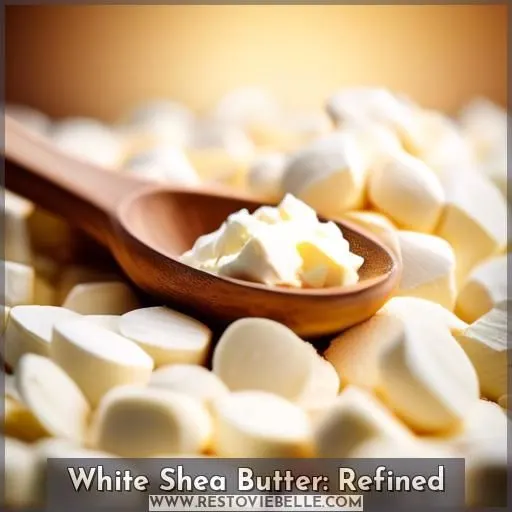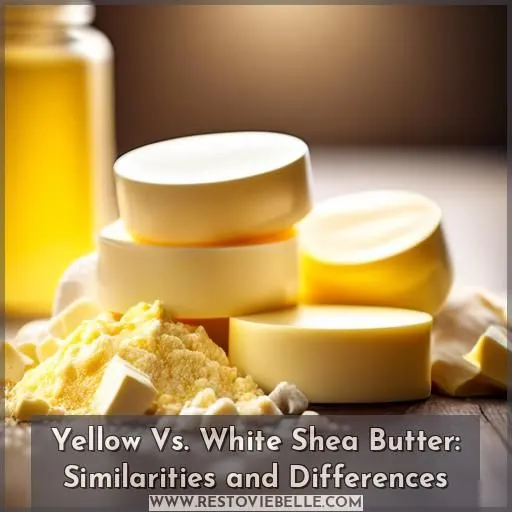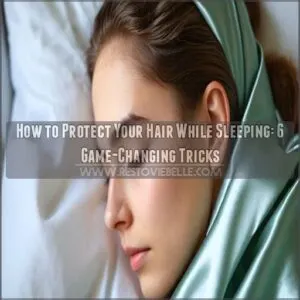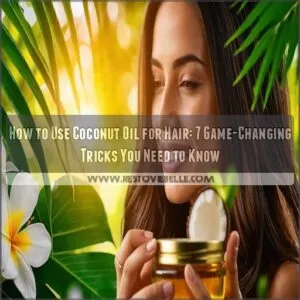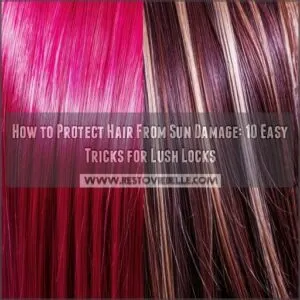This site is supported by our readers. We may earn a commission, at no cost to you, if you purchase through links.
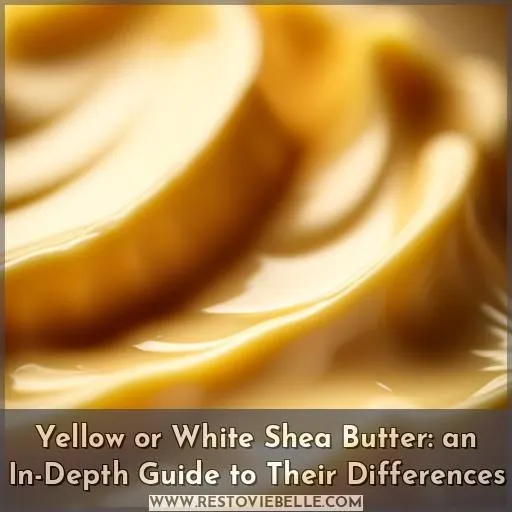
Regarding shea butter, you’ll encounter two distinct types – yellow (unrefined) and white (refined). The yellow shea butter retains more of the inherent components, yielding a stronger aroma and taste. The white variety undergoes further processing to eliminate impurities, color, and odor, making it more appropriate for cosmetic applications.
Both provide hydrating and nourishing benefits for skin and hair, with the yellow variant potentially containing higher levels of beneficial fatty acids and antioxidants.
To select the right shea butter for your needs, consider the intended use. The yellow variety may be preferable for its stronger scent and potential for enhanced skin and hair benefits, while the white version is better suited for cosmetic applications where a more neutral aroma is desirable.
Table Of Contents
- Key Takeaways
- Shea Butter Extraction
- Shea Butter Properties
- Shea Butter Uses
- Shea Butter Benefits
- Shea Butter Precautions
- Yellow Shea Butter: Unrefined
- White Shea Butter: Refined
- Yellow Vs. White Shea Butter: Similarities and Differences
- Frequently Asked Questions (FAQs)
- What is the difference between yellow and white shea butter in terms of processing?
- How does the refining process affect the nutrient content of shea butter?
- Can yellow shea butter be used for cooking or is it only for cosmetic purposes?
- Is there a difference in the scent of yellow and white shea butter?
- How does the color of shea butter affect its marketability and consumer preferences?
- Conclusion
Key Takeaways
- Yellow shea butter is unrefined and retains more of the inherent components, resulting in a stronger aroma and taste.
- White shea butter undergoes further processing to eliminate impurities, color, and odor, making it more appropriate for cosmetic applications.
- Both yellow and white shea butter provide hydrating and nourishing benefits for skin and hair, with the yellow variant potentially containing higher levels of beneficial fatty acids and antioxidants.
- The color of shea butter can vary from white to yellow, depending on the method of production, and both colors provide the same benefits, with the yellow color often used to enhance product appeal.
Shea Butter Extraction
To comprehend the discrepancies between yellow and white shea butter, we must first explore their extraction techniques.
Shea nuts are gathered, split, roasted, and crushed to retrieve the butter.
The butter is then simmered in water until it ascends to the top, gathered into vessels, and allowed to cool and solidify.
Manual extraction procedures preserve more unprocessed components in the butter, while refining eliminates color and imperfections, possibly diminishing the aroma.
Shea butter preservation and excellence rely on the equipment employed for extraction.
Unrefined shea butter, also known as raw shea butter, is extracted from the shea tree and exhibits a faint yellow coloration.
Shea Butter Properties
Shea butter, derived from the nuts of the African Shea tree, is known for its moisturizing and nourishing properties.
It’s often used in cosmetics and skincare products due to its ability to soothe dry skin, reduce inflammation, and provide natural UV protection.
The extraction process involves cracking, grilling, and pounding the nuts to release the butter, which is then boiled and cooled to set.
The color of the butter can vary from white to yellow, depending on the method of production.
Unrefined yellow shea butter is created by adding organic root dye during milling.
White shea butter is refined using heat, which can remove impurities and fragrance but also up to 75% of bioactive ingredients.
Both colors provide the same benefits, with the yellow color often used to enhance product appeal.
Shea Butter Uses
Yellow and white shea butter have a wide range of uses, from cosmetics to hair care applications.
Both types of shea butter are edible, but yellow shea butter isn’t commonly consumed due to its strong scent.
Shea butter is known for its moisturizing properties, making it an excellent choice for dry skin and hair.
It also provides natural UV protection, which is beneficial for those with sensitive skin.
Additionally, shea butter has anti-inflammatory properties, making it effective in treating scars, eczema, burns, rashes, and dry skin.
In hair care, shea butter can be used as an all-natural conditioner and can promote quicker healing of small wounds and cuts.
It can also be used as a makeup remover and is safe for use on babies, children, and adults.
Shea Butter Benefits
The multitude of benefits offered by shea butter stems from its rich composition of essential fatty acids, vitamins, and antioxidants that nourish and protect the skin and hair. Whether you opt for the raw, unrefined yellow shea butter or the refined white variety, you’ll reap advantages such as enhanced moisturization, anti-inflammatory properties, and protection against UV damage.
Shea Butter Properties
Yellow or White Shea Butter: Unveiling the Potential of Nature
Shea butter is a versatile component renowned for its hydrating qualities and cosmetic advantages. It presents itself in two variations: yellow and white. The yellow shea butter remains unrefined, preserving its inherent hue and nutrients, whereas white shea butter undergoes refinement, resulting in a paler shade and potentially diminished nutrient content. Both variations possess distinct characteristics and applications, catering to diverse skincare and haircare requirements.
Yellow shea butter, brimming with abundant nutrients, frequently attracts individuals seeking a more natural and unaltered product. It stands out in skincare, delivering profound hydration and nourishment. Its robust aroma and unprocessed texture resonate with those who cherish the innate qualities of the product.
Conversely, white shea butter undergoes refinement, yielding a smoother texture and lighter shade. It garners widespread use in the cosmetic industry owing to its hydrating properties for skin and hair. However, it may incorporate chemicals, which certain consumers opt to avoid.
Upon selecting between yellow and white shea butter, contemplate your preferences and intended purpose. If you yearn for a more natural, unrefined product imbued with a stronger scent and unprocessed texture, yellow shea butter emerges as the choice. For a refined, smoother texture, white shea butter stands as the optimal selection.
Shea Butter Benefits
Explore the realm of shea butter, your potent elixir for well-being and allure. From parched skin’s solace to unruly hair’s discipline, shea butter’s virtues are as multifaceted as your grandmother’s culinary wisdom. Banish cosmetic woes and dilemmas; shea butter offers a sanctuary, devoid of allergic woes. It’s nature’s decree for your quest for dominion and liberation.
Shea Butter Uses
Shea butter is a versatile ingredient with numerous uses across various applications, including hair and skin care, DIY recipes, and lifestyle uses. Here are some of the key ways you can incorporate shea butter into your daily routine:
- Hair:
- Shea butter is an excellent conditioner for dry, damaged hair, helping to restore moisture and prevent breakage.
- It can be used as a leave-in treatment, especially for curly hair, to help define curls and reduce frizz.
- For straight and fine hair, apply shea butter to the ends to help with split ends and add shine.
- Skin:
- Shea butter is a rich source of vitamins A and E, which can help to rejuvenate rough or damaged skin.
- It has anti-inflammatory properties, making it suitable for soothing eczema, psoriasis, and other skin conditions.
- Apply shea butter to the skin to help reduce the appearance of wrinkles and fine lines, as well as to improve skin elasticity.
- DIY Recipes:
- Shea butter can be used as a base for various DIY skincare and haircare products, such as body scrubs, lip balms, and hair masks.
- Mix shea butter with other natural ingredients like essential oils, honey, or aloe vera to create customized skincare and haircare treatments.
- Lifestyle Uses:
- Shea butter can be used as a replacement for shaving cream, providing a smooth, moisturizing shave.
- Apply shea butter to the lips to help prevent chapping and keep them soft and supple.
- Use shea butter on the nail cuticles to help maintain healthy, strong nails.
- Medicinal Uses:
- Shea butter has been used in traditional medicine for its anti-inflammatory properties, helping to reduce inflammation and pain in conditions like arthritis and sore muscles.
- It may also have antibacterial properties, making it a potential treatment for acne and other skin infections.
- Borututu Root and Tree:
- Shea butter is extracted from the nuts of the shea tree, which is also known as the karite tree.
- The tree is native to West and Central Africa and has been used for centuries for its medicinal and cosmetic properties.
- Shea Butter for Cooking:
- Pure shea butter can be used for cooking, adding flavor and nutrition to various dishes.
- It’s commonly used in African cuisine and can be used as a substitute for other fats in recipes.
Remember to store shea butter in a cool, dry place to maintain its quality and effectiveness. Enjoy the many benefits of this versatile ingredient in your daily routine!
Shea Butter Precautions
When working with shea butter, it’s imperative to take some precautions to guarantee the best outcomes and avert potential problems. Here are some key factors to ponder:
- Crystallization Prevention: Shea butter can crystallize if not heated and cooled appropriately. To prevent this, heat the butter to 175 degrees Fahrenheit for at least 20 minutes before cooling it down.
- Overheating Effects: Overheating shea butter can result in a loss of its beneficial properties. It’s pivotal to avoid excessive heat during the extraction and processing stages.
- Safe Temperature Range: Store shea butter in a cool, dry place to preserve its quality and consistency.
- Mixing for Consistency: If you find that your shea butter has crystallized, you can mix it with other ingredients to create a desired consistency.
- Hair Suitability: While shea butter is generally beneficial for hair, it may not work well with all hair types when used straight. You may need to mix it with other ingredients or use it in combination with other products for ideal results.
- Ivory and White Shea Butter: Ivory and white shea butter are fundamentally the same product, but the color difference is often due to the refining process.
- Refined Shea Butter: Refined shea butter may contain chemicals that could affect its healing properties and may not be as beneficial as unrefined shea butter.
Yellow Shea Butter: Unrefined
Yellow shea butter, also known as unrefined shea butter, is the rawest and purest form of shea butter.
It’s produced by harvesting the nuts of the African Shea Tree, which are then pounded into a paste, boiled, and the floating fat on top is collected to create the butter.
Unlike refined white shea butter, yellow shea butter isn’t subjected to chemical processing, which preserves its natural vitamins and nutrients.
This variety is highly beneficial for the skin, providing extensive moisture, promoting collagen growth, and possessing anti-inflammatory properties.
It’s also suitable for all skin types, including sensitive skin, and can be used for various purposes, such as moisturizing, healing, and protecting the skin from environmental elements.
To guarantee quality, look for yellow shea butter that’s unrefined, raw, and organic, and avoid products with added chemicals or dyes.
White Shea Butter: Refined
Switching gears to white shea butter, you’re diving into a world where refinement is key.
This process strips away the butter’s natural color and scent, aiming for a more neutral palette in both appearance and aroma.
While this might sound like a clean slate, it’s critical to ponder the chemical composition and what’s lost in translation.
Safety concerns, ethical considerations, and the environmental impact of such processing beg the question of sustainability.
It’s a balancing act between purity and preserving the essence of what makes shea butter truly remarkable.
Yellow Vs. White Shea Butter: Similarities and Differences
Yellow shea butter retains more vitamins and nutrients compared to white shea butter, as it is unrefined. The refining process for white shea butter removes impurities and fragrance, potentially reducing the butter’s natural scent and color.
White shea butter may contain chemicals, while yellow shea butter is free of such additives. However, white shea butter is safe to eat, whereas yellow shea butter is not.
Some sellers may engage in deceptive practices, dyeing white shea butter to resemble yellow shea butter. Understanding these differences can help you make an informed choice based on your preferences and needs.
Frequently Asked Questions (FAQs)
What is the difference between yellow and white shea butter in terms of processing?
The key difference is in the processing – yellow shea butter is unrefined, preserving its natural vitamins and nutrients, while white shea butter undergoes refining to remove impurities but also loses some of its beneficial properties.
How does the refining process affect the nutrient content of shea butter?
The refining process strips shea butter of many beneficial nutrients. Unrefined yellow shea retains more vitamins and minerals, while refined white shea may contain chemicals that diminish its natural potency. For the best skin health, yellow shea’s superior nutrient profile is ideal.
Can yellow shea butter be used for cooking or is it only for cosmetic purposes?
Hold that pen tight – yellow shea butter packs a punch! While cosmetics are its claim to fame, this versatile wonder can moonlight as a culinary delight, adding a nutty, creamy zing to your favorite dishes.
Is there a difference in the scent of yellow and white shea butter?
You’ll notice a distinct difference in the scents – yellow shea butter has a robust, earthy aroma while the white variety is typically milder and less fragrant. Both offer wonderful skin-nourishing benefits.
How does the color of shea butter affect its marketability and consumer preferences?
You’ll be blown away by the impact of shea butter color! Consumers crave the golden, sun-kissed hue, craving that raw, untamed beauty. Marketers milk this preference, dazzling shelves with vibrant, sun-soaked shea wares that fly off the shelves.
Conclusion
Clearly, shea butter is a skincare marvel that merits a spot in your beauty toolkit. Whether you prefer the fragrant yellow variant or the refined white version, both offer remarkable moisturizing and nourishing advantages for your skin and hair.
When choosing yellow or white shea butter, consider the intended purpose. The yellow butter may be more desirable for its more pronounced scent and potential for added benefits, while the white is better suited for cosmetic uses where a more neutral aroma is preferred.
